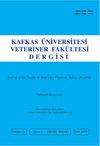Effect of Celery Powder as an Alternative Nitrite Source on Some Quality Properties and Nitrosamine Formation in Sucuk
IF 0.9
4区 农林科学
Q3 VETERINARY SCIENCES
引用次数: 0
Abstract
This study aimed to determine the effects of celery powder (nitrate converted to nitrite) and cooking time on the formation of nitrosamine in sucuk. The microbiological and physicochemical properties were also investigated. Four sucuk batters were prepared: T1 - 100 mg/kg synthetic sodium nitrite, T2 - 150 mg/kg synthetic sodium nitrite, T3 - celery powder equivalent to 100 mg/kg nitrite, T4 - celery powder equivalent to 150 mg/ kg nitrite. After ripening (initial fermentation temperature: 24±1°C, ripening time: 7 days), the samples were subjected to the analyses. Lactic acid bacteria and Micrococcus/ Staphylococcus were not affected by the treatment. T4 treatment showed higher pH values than T1 and T2. The celery powder groups (T3 and T4) showed lower a w values than other groups (T1 and T2). No significant differences were observed between the treatments in terms of thiobarbituric acid reactive substance (TBARS) value, residual nitrite level, N-nitrosodimethylamine (NDMA) and N-nitrosodiethylamine (NDEA) contents. However, N-nitrosopiperidine (NPIP) content was found to have higher in T4 treatment. Cooking time, especially 3 min, caused a significant increase in nitrosamine content. The effect of cooking time on nitrosamines was also revealed in principal component analysis .芹菜粉作为亚硝酸盐替代源对苏克某些品质及亚硝胺生成的影响
本文章由计算机程序翻译,如有差异,请以英文原文为准。
求助全文
约1分钟内获得全文
求助全文
来源期刊
CiteScore
1.50
自引率
14.30%
发文量
56
审稿时长
3-6 weeks
期刊介绍:
The journal publishes full-length research papers, short communications, preliminary scientific reports, case reports, observations, letters to the editor, and reviews. The scope of the journal includes all aspects of veterinary medicine and animal science.

 求助内容:
求助内容: 应助结果提醒方式:
应助结果提醒方式:


